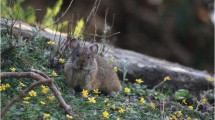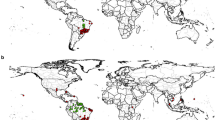Abstract
Climate change is expected to impact the geographic distribution of marsupial species in the near future and this impact is likely to be accentuated for the more specialist species. The water opossum (Chironectes minimus) is the only semiaquatic marsupial in the world and is considered naturally rare throughout its geographical range. In the present study, we use ecological niche modeling (ENM) to predict the potential impacts of climate change on the geographic distribution of water opossum throughout Neotropical Region at the end of twenty-first century. We assess the vulnerability of this species by calculating its biotic velocity and identifying potential areas for the conservation of the water opossum based on the changes in climatically stable areas over time. These areas were also compared with the availability of remnant forest in the future. The area of potential distribution of the water opossum is projected to decrease 22% in the future. Water opossum populations will be more vulnerable to climate change in central Brazil, toward the southern extreme, and in some regions of the Amazon biome. In the future, C. minimus may be unable to colonize some areas in southern South America and in Mexico. Climatically stable areas are found in Central America, northwestern and coastal areas in northern South America, and southeastern Brazil, however, most of these areas will not have remnant forest in the future. Climatically stable areas with remnant forest areas are an opportunity for the development of effective long-term conservation measures for C. minimus.




Similar content being viewed by others
References
Araújo MB, Rahbek C (2006) How does climate change affect biodiversity? Science 313:1396–1397. https://doi.org/10.1126/science.1131758
Ardente N, Gettinger D, Fonseca R, Bergallo HG, Martins-Hatano F (2013) Mammalia, Didelphimorphia, Didelphidae, Glironia venusta (Thomas, 1912) and Chironectes minimus (Zimmermann, 1780): Distribution extension for eastern Amazonia. Check List 9(5):1104–1107. https://doi.org/10.15560/9.5.1104
Ashcroft MB (2010) Identifying refugia from climate change. J Biogeogr 37:1407–1413. https://doi.org/10.1111/j.1365-2699.2010.02300.x
Brandão MV, Garbino GST, Godoy LP, Silva LA, Pascoal W (2014) New record of Chironectes minimus (Zimmermann, 1870) (Didelphimorphia, Didelphidae) from central Brazil, with comments on its distribution pattern. Mammalia 17:363–368. https://doi.org/10.1515/mammalia-2014-0037
Bressiani V, Graipel ME (2008) Comparação de métodos para captura da cuíca—d’água, Chironectes minimus (Zimmerman, 1780) (Mammalia, Didelphidae) no Sul do Brasil. Mastozoologia Neotropical 15(1):33–39
Brito D (2009) Genetic consequences of populations subdivision: the marsupial Micoureus paraguayanus (Mammalia: Didelphimorphia) as a case study. ZOOLOGIA 26(4):684–693
Brooks TM, Mittermeier RA, Fonseca GAB, Gerlach J, Hoffmann M, Lamoreux JF, Mittermeier CG, Pilgrim JD, Rodrigues ASL (2006) Global biodiversity conservation priorities. Science 313:58–61. https://doi.org/10.1126/science.1127609
Carrol C, Lawler JJ, Roberts DR, Hamann A (2015) Biotic and climatic velocity identify contrasting area of vulnerability to climate change. PLoS ONE 10(10):1–18. https://doi.org/10.1371/journal.pone.0140486
Clavel J, Julliard R, Devictor V (2011) Worldwide decline of specialist species: toward a global functional homogenization? Front Ecol Environ 9(4):222–228. https://doi.org/10.1890/080216
Dormann CF, Elith J, Bacher S, Buchmann C, Carl G, Carré G, Marquez JRG, Gruber B, Lafourcade B, Leitão PJ, Munkemuller T, McClean C, Osborne PE, Reineking B, Schroder B, Skidmore AK, Zurell D, Lautenbach S (2012) Collinearity: a review of methods to deal with it and a simulation study evaluating their performance. Ecography 36:27–46. https://doi.org/10.1111/j.1600-0587.2012.07348.x
Estavillo C, Pardini R, da Rocha PLB (2013) Forest loss and the biodiversity threshold: an evaluation considering species habitat requirements and the use of matrix habitats. PLoS ONE 8(12):1–10. https://doi.org/10.1371/journal.pone.0082369
Fernandez ASF, Galliez M, de Leite SM, Queiroz TL, Palmeirim AF (2015) Natural history of the water opossum Chironectes minimus: a review. Oecol Aust 19:47–62. https://doi.org/10.4257/oeco.2015.1901.04
Fox J, Weisberg S (2019) An Companion to Applied Regression, Third Edition. Thousand oaks CA: Sage. https://socialsciences.mcmaster.ca/jfox/Books/Companion/
Franklin J (2009) Mapping species distributions: spatial inference and predictions. Cambridge University Press
GBIF.org (10 November 2017) GBIF Occurrence Download https://doi.org/10.15468/dl.bq3h74
Gonçalves F, Hannibal W, Godoi MN, Martins FI, Oliveira RF, Figueiredo VV, Casella J, De Sá EFGG (2018) Non-volant mammals from the Upper Paraná River Basin: a data set from a critical region for conservation in Brazil. Ecology 99(2):499. https://doi.org/10.1002/ecy.2107
Graham V, Baumgartner JB, Beaumont LJ, Esperón-Rodrígues M, Grech A (2019) Priortizing the protection of climate refugia: designing a climate-ready protected area network. J Environ Planning Manage 62(14):2588–2606. https://doi.org/10.1080/09640568.2019.1573722
Groves CR, Game ET, Anderson MG, Cross M, Enquist C, Ferdana Z, Girvetz E, Gondor A, Hall KR, Higgins J, Marshall R, Popper K, Schill S, Shafer SL (2012) Incorporating climate change into systematic conservation planning. Biodivers Conser 21:1651–1671. https://doi.org/10.1007/s10531-012-0269-3
Hamann A, Roberts DR, Barber Q, Carrol C, Nielsen SE (2015) Velocity of climate change algorithms for guiding conservation and management. Glob Change Biol 21:997–1004. https://doi.org/10.1111/gcb.12736
Hannah L, Midgley G, Andelman S, Araújo M, Hughes G, Martinez-Meyer E, Pearson R, Williams P (2007) Protected area needs in a changing climate. Front Ecol Environ 5:131–138. https://doi.org/10.1890/1540-9295(2007)5[131:PANIAC]2.0.CO;2
Hijmans RJ (2017) Raster: Geographic Data Analysis and Modeling. R package. https://CRAN.R-project.org/package=raster. Accessed 10 November 2017
Hijmans RJ, Phillips S, Leathwick J, Elith J (2017) Dismo: Species Distribution Modeling. R package version 1. 1–4. https://CRAN.R-project.org/package=dismo. Accessed 10 November 2017
Hurtt GL, Chini R, Sahajál S, Frolking S, Bodirsky BJ, Calvin K, Doelman JC, Fisk J, Fujimori S, Goldewijk KK, Hasegawa T, Havlik P, Heinimann A, Humpenoder F, Jungclaus J, Kaplan JO, Kennedy J, Krisztin T, Lawrence D, Lawrence P, Ma L, Mertz O, Pongratz J, Popp A, Poulter B, Riahi K, Shevliakova E, Stehfest E, Thornton P, Tubiello FN, Vuuren DPV, Zhang X (2020) Harmonization of global land use change and management for the period 850–2100 (LUH2) for CMPI6. Geosci Model Dev 13: 5425–5464. https://gmd.copernicus.org/articles/13/5425/2020/
ICMBIO (2016) Pontos de ocorrências de Chironectes minimus: Miranda GB, Galliez M, Beisiegel BM. Portal da biodiversidade—SISBIO-DIBIO. https://biodiversidade.icmbio.gov.br. (Acessed 04 August 2016)
Jones KR, Watson JEM, Possingham HP, Klein CJ (2016) Incorporating climate change into spatial conservation prioritisation: a review. Biol Cons 194:121–130. https://doi.org/10.1016/j.biocon.2015.12.008
Karatzoglou A, Smola A, Hornik K, Zeileis A (2004) Kernlab- Na S4 Packages for Kernel Methods in R. J Statistical Software 11(9):1–20. http://www.jstasoft.org/v11/i09/. Acessed 10 November 2017
Keppel G, Wardell-Johnson GW (2012) Refugia: keys to climate change management. Glob Change Biol 18:2389–2391. https://doi.org/10.1111/j.1365-2486.2012.02729.x
Keppel G, Mokany K, Wardell-Johnson GW, Phillips BL, Welbergen JA, Reside AE (2015) The capacity of of refugia for conservation planning under climate change. Front Ecol Environ 13(2):106–112. https://doi.org/10.1890/140055
Lima-Ribeiro MS, Varela S, González-Hernández J, Oliveira G, Diniz-Filho JAF, Terribile LC (2015) ecoClimate: a database of climate data from multiple models for past, present and future for Macoecologist and Biogeographers. Biodiversity Inform 10:1–21. https://doi.org/10.17161/bi.v10i0.4955
Loyola RD, Lemes P, Faleiro FV, Trindade-Filho J, Machado RB (2012) Severe loss of suitable climatic conditions for marsupial species in Brazil: challenges and opportunities for conservation. PLoS ONE 7(9):1–9. https://doi.org/10.1371/journal.pone.004625
Manel S, Williams HC, Ormerod SJ (2001) Evaluating presence-absence models in ecology: the need to account for prevalence. J Appl Ecol 38:921–931
McDonald-Spicer CJ, Moritz CC, Ferrier S, Rosauer DF (2019) The importance of defining measures of stability in macroecology and biogeography. Front Biogeogr 11(3):1–13. https://doi.org/10.21425/F5FBG43355
Moritz C, Patton JL, Conroy CJ, Parra JL, White GC, Beissinger SR (2008) Impact of a century of climate change on small-mammal communities in Yosemite national park, USA. Science 322:261–264. https://doi.org/10.1126/science.1163428
Moss RH, Edmonds JA, Hibbard KA, Manning MR, Rose SK, van Vuuren DP, Carter RT, Emori S, Kainuma M, Kram T, Meehl GA, Mitchell JFB, Nakicenovic N, Riahi K, Smith SJ, Stouffer RJ, Thomson AM, Weyant JP, Wilbanks TJ (2010) The next generation of scenarios for climate change research and assessment. Narute 463:747–756. https://doi.org/10.1038/nature08823
Oksanen J, Blachet FG, Friendly M, Kindt R, Legendre P, McGlinn D, Minchin PR, O’Hara RB, Simpson GL, Solymos P, Stevens MHH, Szoecs E, Wagner H (2017) Vegan: Community Ecology Package. R package. Version 2.4-3. Accessed 10 November 2017
Ordonez A, Williams JW (2013) Climatic and biotic velocities for woody taxa distribution over the last 16 000 years in eastern North America. Ecol Lett 16:773–791. https://doi.org/10.1111/ele.12110
Parmesan C (2006) Ecological and evolutionary responses to recent climate change. Annu Rev Ecol Evol Syst 37:637–669. https://doi.org/10.1146/annurev.ecolsys.37.091305.110100
Pearson RG, Raxworthy CJ, Nakamura M, Townsend Peterson A (2007) Predicting species distributions from small numbers of occurrence records: a test case using cryptic geckos in Madagascar. J Biogeogr 34:102–117. https://doi.org/10.1111/j.1365-2699.2006.01594.x
Prieto-Torres DA, Pinilla-Buitrago G (2017) Estimating the potential distribution and conservation priorities of Chironectes minimus (Zimmermann, 1780) (Didelphimorphia; Didelphidae). THERYA 8(2):131–144. https://doi.org/10.12933/therya-17-478 (ISSN 2007-3364)
R Core Team (2017) R: A language and environment for statistical computing (version 3.4.3). R Foundation for Statistical Computing, Vienna, Austria. https://www.R-project.org/. Acessed 10 November 2017
Regos A, Gagne L, Alcaraz-Segura D, Honorado JP, Domínguez J (2019) Effects of species traits and environmental predictiors on performance and transferability of ecological niche models. Sci Rep 9:4221. https://doi.org/10.1038/s41598-019-40766-5
Ribeiro MC, Metzger JP, Martensen AC, Ponzoni FJ, Hirota MM (2009) The Brazilian Atlantic forest: how much is left, and how is the remaining forest distributed? Implications for conservation. Biol Cons 142:1141–1153. https://doi.org/10.1016/j.biocon.2009.02.021
Ribeiro BR, Sales LP, de Marco P, Loyola R (2016) Assessing mammal exposure to climate change in the Brazilian Amazon. PLoS ONE 11:1–13. https://doi.org/10.1371/journalpone.0165073
Taylor KE, Stouffer RJ, Meehl GA (2012) An overview of CMPI5 and the experiment design. Bullet Am Meteorol Soc 93(4):485–498. https://doi.org/10.1175/BAMS-D-11-00094.1
Terribile LC, Lima-Ribeiro MS, Araújo MB, Bizão N, Collevatti RG, Dobrovolski R, Franco AA, Guilhaumon F, Lima JS, Murakami DM, Nabout JC, Oliveira G, Oliveira LK, Rabelo SG, Rangel TF, Simon LM, Soares TN, Telles MPC, Diniz-Filho JAF (2012) Areas of climate stability of species ranges in the Brazilian cerrado: disentangling uncertainties through time. Natureza e Conservacao 10(2):152–159. https://doi.org/10.4322/natcon.2012.025
Warren MS, Hill JK, Thomas JA, Asher J, Rox R, Huntley B, Roy DB, Telfer MG, Jeffcoate S, Harding P, Willis SG, Greatorex-Davies JN, Moss D, Thomas CD (2001) Rapid response of British buttlerflies to opposing forces of climate and habitat change. Nature 414:65–69. https://doi.org/10.1038/35102054
Acknowledgements
This study was developed within the scope of the National Institutes for Sciences and Technology (INCT) Program in Ecology, Evolution and Biodiversity Conservation, supported by MCTIC/CNPq (proc. 465610/2014-5) and FAPEG (proc. 201810267000023). The research of LCT and MSLM is supported by CNPq productivity grants. We thank two anonymous reviewers for their constructive comments.
Author information
Authors and Affiliations
Corresponding author
Ethics declarations
Conflict of interest
The authors declared that they have no conflict of interest.
Additional information
Publisher's Note
Springer Nature remains neutral with regard to jurisdictional claims in published maps and institutional affiliations.
Handling editor: Adriano Martinoli.
Supplementary Information
Below is the link to the electronic supplementary material.
Rights and permissions
About this article
Cite this article
Freitas-Oliveira, R., Hannibal, W., Lima-Ribeiro, M.S. et al. Implications of climate change for the distribution of the water opossum (Chironectes minimus): habitat loss and conservation opportunities. Mamm Biol 101, 729–737 (2021). https://doi.org/10.1007/s42991-021-00105-6
Received:
Accepted:
Published:
Issue Date:
DOI: https://doi.org/10.1007/s42991-021-00105-6




